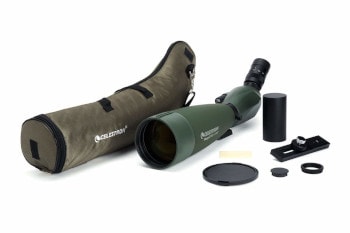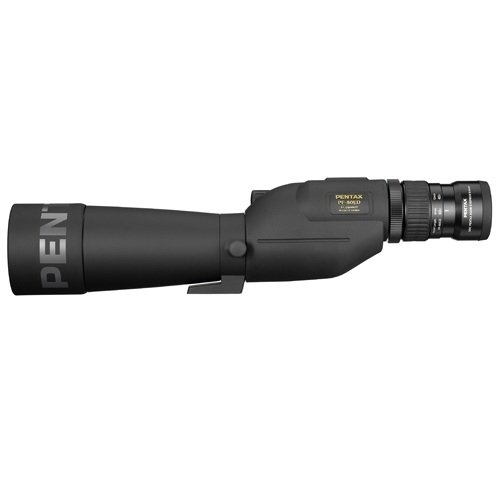5 Best Spotting Scopes Under $1000 of 2024 – Reviews & Buying Guide
Last Updated on

You could get a spotting scope that costs more than $2000, or you could go cheap and find one for less than $200. Either way, it can be hard to tell if you’re getting good value. After all, it’s sometimes unclear what separates a $2000 spotting scope from a $200 one.
The good news is that there’s a sweet spot where you start to get the features of the most expensive spotting scopes at prices that are closer to the bottom end of the spectrum. Here’s a list of the best spotting scopes under $1000.
We hope that these reviews help you find the model that’s right for you and that comes at a price you’ll like. If you’re new to buying spotting scopes, we even included a buyer’s guide so that you can learn about spotting scopes. Once you’re done, you should be able to get the spotting-scope experience you’ve always wanted to have.
A Quick Glance at Our Favorites (Updated in 2024)
| Image | Product | Details | ||
|---|---|---|---|---|
| Best Overall |
 |
Vortex Razor |
|
CHECK PRICE |
 |
Pentax PF-80ED |
|
CHECK PRICE | |
| Best Value |
 |
Celestron Regal M2 100ED |
|
CHECK PRICE |
 |
Athlon Optics |
|
CHECK PRICE | |
 |
Leupold SX-1 Ventana |
|
CHECK PRICE |
5 Best Spotting Scopes Under $1000
1. Vortex Razor Spotting Scope – Best Overall
The Vortex Razor HD RS-65A is a great choice for anyone who needs a great spotting scope with variable zoom. The minimum zoom 22x is better than what you can find on most pairs of binoculars, and the maximum zoom of 48x gives you the ability to peer far into the distance. Of course, the power wouldn’t matter if the optics weren’t great, but the 65-millimeter lens lets in a ton of light and provides crystal-clear images even at maximum power.
Even better, this model clocks in at less than four pounds, so while it’s a bit bulky, it is light enough to take along on most expeditions. The one problem with this model has nothing to do with its construction or clarity, instead having to do with the case. It comes with a soft case, which is good for light travel, but there’s no option to purchase a hard case, so if you want one, you’re out of luck. Overall, this is one of the best spotting scopes on the market, and getting it for less than $1000 is a steal.
- Variable zoom
- Large lens
- Crystal-clear optics
- Lightweight
- No hard case
2. Pentax PF-80ED Spotting Scope
The Pentax PF-80ED 70930 has enough upside to put it in second place on our list but has too many problems to place it any higher. It comes with a very large 80-millimeter lens, which creates bright images and captures a lot of detail, even at high levels of magnification. It is compatible with 1¼-inch eyepieces, which means that you already own some of those popular models, you can use them interchangeably with this spotting scope.
This model also comes with ED-glass, which is short for “Extra-low Diffraction,” which is designed to reduce chromatic aberration by aligning the different colors of the spectrum before they reach your eye. Unfortunately, this doesn’t work as well as promised, as the only real problem with this model is that it has chromatic aberration and a bit of blurriness around the edges of the view. While it’s not enough to knock it further down the list, it is enough to knock it out of first. If you’re looking for a spotting scope compatible with 1¼-inch eyepieces and that has a high potential maximum power, this model is worth checking out.
- Very large lens
- ED glass
- Compatible with 1¼ inch eyepieces
- Some chromatic aberration
- Some blurring
3. Celestron Regal M2 100ED Spotting Scope – Best Value
The Celestron 52306 Regal M2 100ED is a spotting scope that bills itself as a great spotting scope for taking photos, and it’s easy to understand why. It comes with a massive 100-millimeter lens that produces bright, sharp, clear images, even at high powers. It’s made with ED-glass, so you know you’ll get a great experience even in suboptimal weather conditions. It even comes with a 22-67x eyepiece, though it’s compatible with any eyepiece in the 1¼-inch line, so if another one suits your fancy better, you can use that instead.
Despite the fact this model is a monster of a spotting scope, it only weighs 5 pounds. That’s due to the fact it has a magnesium alloy body, which is both stronger and lighter than a comparable aluminum one. However, the weight is not well-distributed, and unless you have a monster tripod, you’ll often feel that this model wants to slump forwards or backward, which can be a pain when you’re trying to take pictures using the included t-mount adapter. However, since this model is less expensive than others on this list, you’ll be able to afford a monster tripod, and that makes this a great deal.
- Massive lens
- ED glass
- Great power
- Strong but lightweight
- Unbalanced
4. Athlon 20-60×85 Spotting Scope
The Althlon Optics 20-60×85 ED 312001 is a spotting scope with some potential, but that you could probably pass on and get better value elsewhere. It comes with good power, as it comes with an eyepiece that can adjust between 20x and 60x magnification. That power is justified as it has a very large 85-millimeter lens, which has ED glass. You get good contrast, sharpness, and vivid colors with this model, especially at lower powers.
However, it doesn’t come with a hard case, which is one of those things that can make you nervous during travel, especially for an investment of this price. It’s also quite bulky relative to the other models on this list, which makes it not as good for traveling either. If you planned to keep this stationary at your home for stargazing or other purposes, then it might be a good buy. If you’re looking for something especially mobile, you may need to look elsewhere.
- Good power
- Large lens
- ED glass
- No hard case
- Bulky
5. Leupold SX-1 Ventana Spotting-Scope
While many Leupold products are high-quality and more than worth their prices, the Leupold XS-1 Ventana 170762 raises a lot of questions about whether that reputation is deserved. First, we need to point out that this model comes with a tripod and a hard case, features that are sorely lacking on other, more expensive spotting scopes. It also comes with an expanding lens shade that can be used to reduce brightness on sunny days or to use the spotting scope on rainy days.
Our complaints are about the optics, as they work well enough without being exceptional at most ranges. However, when you move into high magnification, the image quality begins to degrade dramatically, and the spotting scope becomes unusable. The build quality of both the tripod and the hard case is suspect, as both are prone to breaking. Finally, the spotting scope itself feels far cheaper than it out to at this price point. Overall, you could spend more money or less money and get better value than if you purchased this spotting scope.
- Included tripod and hard case
- Lens shade
- Poor performance at high magnification
- Poor quality materials
Buyer’s Guide: Finding the Best Spotting Scope Under $1000
Optics
If you were forced to buy a spotting scope based on only two attributes, they should be optics and portability. If the optics are no good, then the spotting scope is pretty much useless. One of the first ways to tell if you’re getting a scope with good optics is to look at a pair of numbers that are used to identify every spotting scope. Those numbers look like this: “20×60.” The “20” represents the magnification, also called “power,” of the spotting scope. If there are two numbers in a range, for example, “20-60×60,” then the spotting scope comes with variable zoom.
The number after the “x” is the lens’ diameter in millimeters. In this case, it would be “60” millimeters. In this price range, you shouldn’t consider anything under 60 millimeters in diameter, and bigger is generally better as it lets in more light and allows for a higher-detail image.
Portability
Spotting scopes are generally meant to be taken out into nature so that you can enjoy them to their fullest extent. That means that if they aren’t very portable, you’re not getting good value. The most portable spotting scopes feature heavy-duty materials in their shells that allow them to be sturdy, but also lightweight. You may also want to look for rubber-coated models, as that coating makes them easier to grip, but also protects them if dropped, which makes for a good deal.
You’ll also want to look at the case quality. These days, going out into nature often means getting in the car and going for a drive, so you’ll want to have a good case that will protect your spotting scope in transit. Many spotting scopes come with only a soft case, which does a good job of protecting the spotting scope from scuff marks or dings but does little to protect it from accidents that would cause real damage. If possible, you should invest in a model that comes with a hard case or has a hard case available for purchase.
Related:

Conclusion:
The Vortex Razor HD RS-65A is our top pick with its variable zoom and crystal-clear optics. The Pentax PF-80ED 70930 has a bit of haziness and chromatic aberration that keeps it out of first, but it does come with a massive lens and great power. The Celestron 52306 Regal M2 100ED is great for photography, but also comes at a great price, making it the best value on our list. The Athlon Optics 20-60×85 ED 312001 works well enough, but it’s bulky and doesn’t have a hard case, which makes it suboptimal for travel. Leupold XS-1 Ventana 170762 works okay, but it comes with low-quality accessories, and it’s built the best itself.
Hopefully, these reviews have helped you see what matters and what can be safely ignored when you shop for spotting scopes. With this information, you should be able to discover the perfect spotting scope for you.
About the Author Robert Sparks
Robert’s obsession with all things optical started early in life, when his optician father would bring home prototypes for Robert to play with. Nowadays, Robert is dedicated to helping others find the right optics for their needs. His hobbies include astronomy, astrophysics, and model building. Originally from Newark, NJ, he resides in Santa Fe, New Mexico, where the nighttime skies are filled with glittering stars.
Related Articles:
Holy Stone Drone Review of 2024 – Pros, Cons, and Verdict
Ultraviolet Light vs Black Light: What’s the Difference?
Light Waves vs. Sound Waves: How Are They Different?
Infrared vs. Thermal Cameras: How Are They Different?
Far Infrared vs Near Infrared: What’s The Difference?
Mottled Duck vs. Mallard vs. Black Duck: What’s the Difference?
Shutter Speed vs Frame Rate: Pros, Cons, & Difference
Oriole vs Goldfinch: How to Tell the Difference








